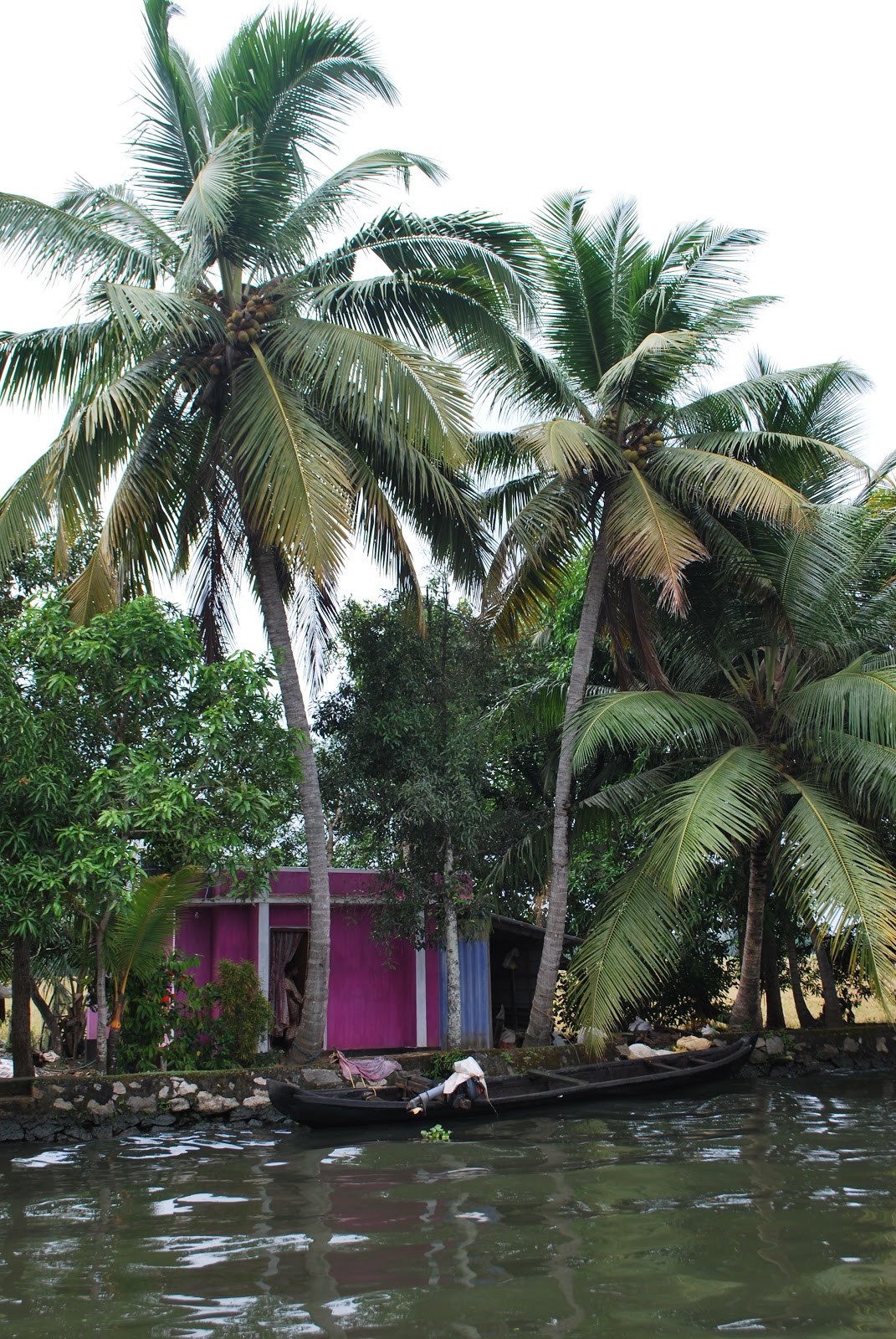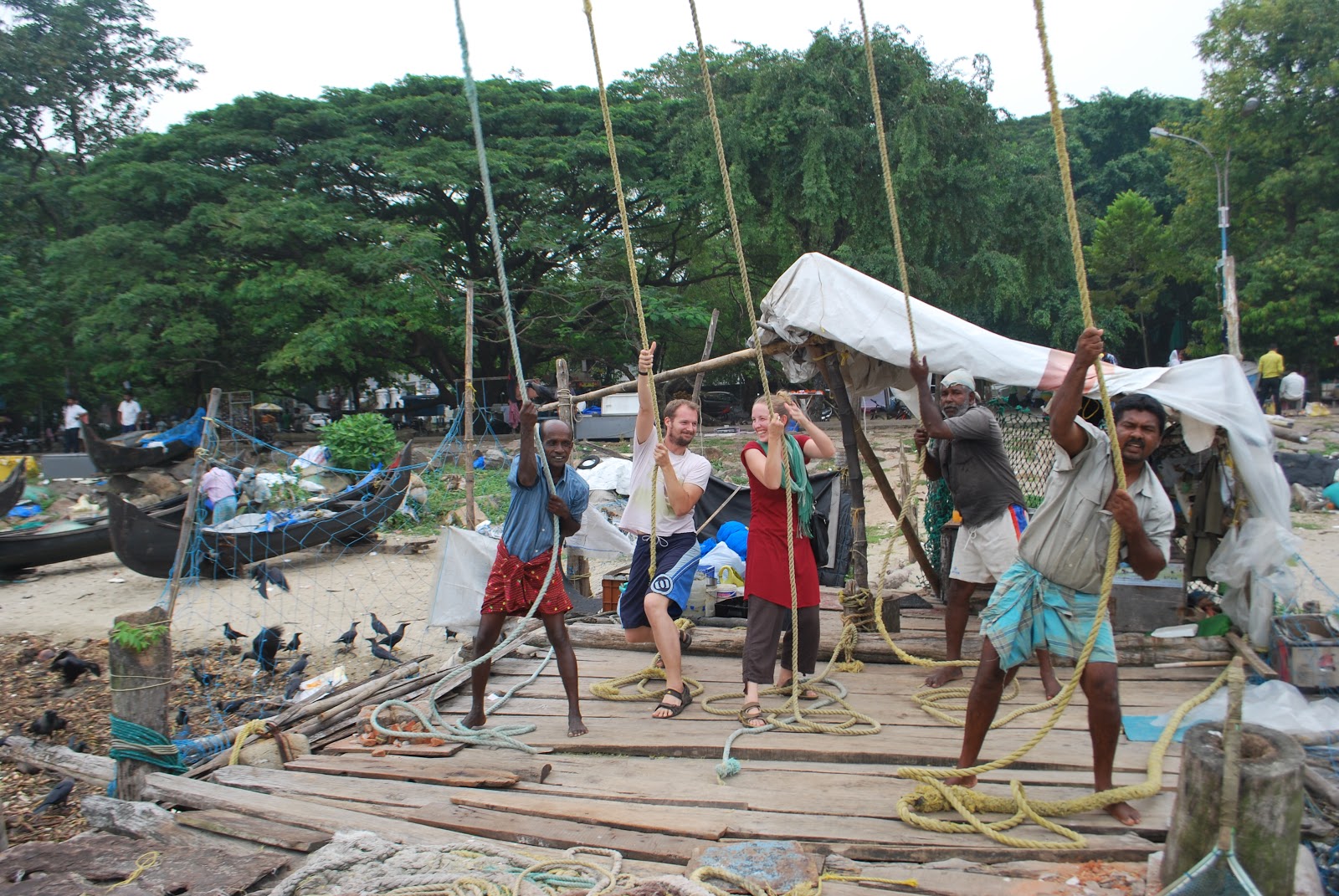Goa
The beach at Arambol curves in a long majestic bow, with powerful waves in the warm sea crashing against a palm-fronded sandy beach. As we stood breathing in the night air, the laughter and music of bars and restaurants rippled along the shore, carried on the breeze into the vast open sky. Here we were, Goa - the recovering addict. The world´s party capital in the 1990s, now the chilled beach resort learning to live again without its all night trance raves.
We slipped slowly into total beach holiday mode here. Sunbathing and swimming took up most of our days. Fresh seafood came in off the boats daily, and good restaurants cooked up grilled calamari, plump prawns and sweet clams. We had a real return to good Italian food with amazing pasta at the Relax Inn and proper thin crust pizza at Fellini's. On the more traditional front, I wolfed down a genuine vindaloo (from the Portuguese vin d´alho) - the Goan original still a spicy tomato-sauced dish but with strong garlic and vinegar flavours lending it a sour edge to balance the sweetness of the pork.
I took advantage of more ayurvedic massages - with a man whose hands were less interested in my ass for once. We took to evening yoga on the beach - along with all the other sun-setters practising their asanas; or those meditating, throwing poi or firesticks around; or banging drums, strumming guitars while gypsy-skirted girls swayed their hips to the music. Time telescoped and we sometimes struggled to remember what day it was. We punctuated our week noticeably with two trips out on a rented scooter. Rolling around Indian roads, we stopped by the Anjuna flea market and a host of smaller bays - Asvem, Mandrem, Chapora and more - always buying a pineapple from a beach-seller and having it freshly cut before our eyes, to be juicily devoured before getting tainted with sand.
With the music shut down from 10pm in the evening, Goa´s nightlife has changed forever. With the exodus of European hedonists, Russians have swarmed in. Game Indians now speak a smattering of Russian and have started adding mayonnaise to their salads. A hardcore rump of Italians corners some parts of Arambol: while middle-class Northern European couples form an enclave here and there. And hippies continue to regrow like the weed they smoke in Anjuna and Vagator. The make-up of Goa continues to evolve, but the stunning coastline, the practised ease of Goan hospitality and a ready-made infrastructure means it will never be forgotten.
Mumbai
 |
| Cricket on the Maidan in Mumbai |
"Put the meter on!"
"Yes, yes, miss. No tension, no tension..
But there was tension. The Paulo Travels bus from Goa had deliberately dumped us on a motorway turnpike about 15km north of our intended stop - running behind schedule the drivers had decided to jettison the foreigners so that they could skip the drive down to Victoria Terminus. After a sleepless night, Mhairi and I unwittingly trusted the shouts for Colaba and allowed ourselves to be ushered off the bus. Instead of being a stone´s throw from our hostel, we had no idea where we were: and as we watched, a burly taxi driver physically beat other drivers around the chest and arms to get our business. Now we were on the hook for 950 rupees in a taxi ride that should have cost half that, maybe even a third.
A week in Goa had softened us up, and Mumbai suckerpunched us hard. We should never have got off the bus without demanding Victoria Terminus, our stop. The Indian city of dreams, city of Slumdog and Shantaram: it picked us up, shook us down, and smiled.
 |
| A Mumbai double decker bus! |
 Wandering north to the market, we passed one of the highlights of Mumbai: its train station. We'd been told, of course, but nothing prepared us for its magnificent pomp and grandeur. The guide books had been adamant Victioria Terminus, but when we saw it in its eye-popping reality our jaws dropped and we spent about half an hour taking inadequate photos of it, one of which I've kindly reproduced for you to the left. It contrasted sharply with the Gateway of India, a triumphal folly which photographed extremely well... See below, bigger picture.
Wandering north to the market, we passed one of the highlights of Mumbai: its train station. We'd been told, of course, but nothing prepared us for its magnificent pomp and grandeur. The guide books had been adamant Victioria Terminus, but when we saw it in its eye-popping reality our jaws dropped and we spent about half an hour taking inadequate photos of it, one of which I've kindly reproduced for you to the left. It contrasted sharply with the Gateway of India, a triumphal folly which photographed extremely well... See below, bigger picture.
But Mumbai above all is a city to be lived in. The city itself is rich - by Indian standards it is gleaming. Even its slums are rich. Compared to Calcutta and Delhi, the street traffic is well organised, the pavements are clean and the centre exudes the sense of relaxation that money can give. Rickshaws, cows and handcarts are banned in the centre, with neat taxis sporting Western style meters arranged in an orderly fashion on most streets. The con is still on here and there, but Mumbai is more refined and looks West for its influences. It is the only city with Starbucks, and if you really want to spend money on a night out then the bars and restaurants of bankers and Bollywood actors can burn your money like any London joint. The melting pot that draws Pushkars, Bengalis and Tamils in to mix with the more local Maharashtrans and Goans is added to by noticeable foreign clientele - East Africans sip beers in dingy pubs ( at least, with Mhairi and I) and white-faces pop out of the crowd more often than any other major Indian city. While the streets bustle, it is the purposeful bustle of a city going somewhere, not like Calcutta or other thickly crowded Indian cities where everyone is just going everywhere.
And this being India, Mumbai has its own treasure, protected from the smog and heat of the city by a 1 hour boat ride. Elaphanta Island houses a 9th Centurty temple carved into the side of and through a mountain. While our European ancestors where scratching through Roman ruins and building huts from wattle and daub, Indians' forebears were carving intricate giant statues using a level of precision and maths not reached by our northern archipelago for another 500 years. Under thousands of tons of rock with hand tools they dug out might caverns to glorify their deities. The caverns now are preserved for tourists escaping Mumbai's throbbing heart, to be reminded that India's soul is old and deep. Bullet holes still riddle some statues, as they were used for target practise by the illiterate Portuguese imperialist privateers that came to claim the Malabar Coast as "theirs" in the 16th Century.
 |
| Three faces of Shiva. The photo belies it size - this statue is fricking massive. |
But if this trip has taught us anything, since Europeans first started feeling their way through the sub-continent, India is nobody's and everybody's. Even the concept of India is mostly made-up. The only thing that unites Indians is their diversity - Sikhs in Amritsar, Buddhist Ladakhis, Christian Keralans and the swathe of Hindu and Muslims that predominate also tolerate Jainists, Zoroastrians and Zarathrustrans. People of no faith bundle themselves along too. Some places are dry (both of rain and booze) while others are slaked in waters from the heavens and the brewery. Vegetarian or meat-loving, the food astonishes a Western palate, and is more varied than in any other country. From the depths of poverty where street-sleepers collapse at nightfall on pavements in the rags that they own, to billionaires like Lakshmi Mittal or global movie stars like Shah Rukh Khan: there is no typical Indian. And India is both old and new. For us, travelling through the country has allowed us to retrace the steps of ancestors, in awe of their achievements - forcing upon us the due humility as we consider our own accomplishments. And yet it's also allowed us to think about what we might do next, as the vibrant organic change that swarms, bustles and charges around the Indian lands begets creativity and the new. What for us will be the new thing? For the moment, that's Argentina. But in another 4 month's time, who knows?



















































